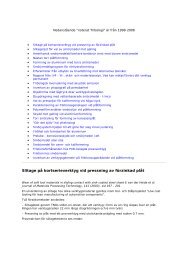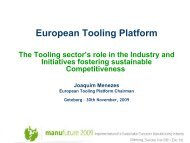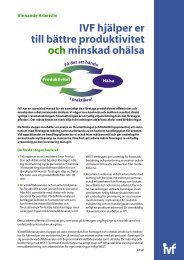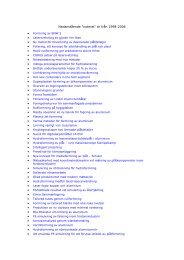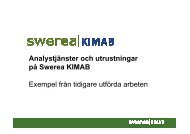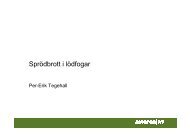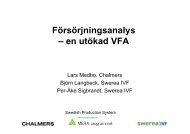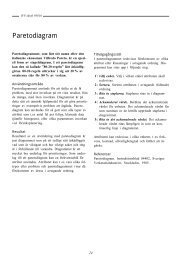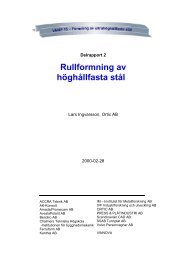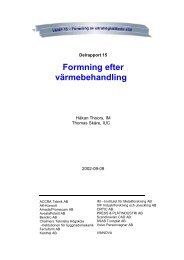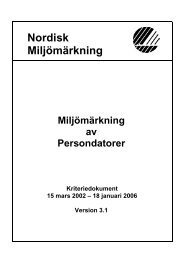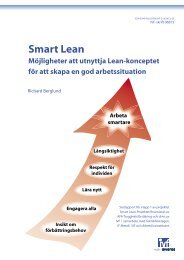plastsep - a new technology for sorting and recycling of cable ... - IVF
plastsep - a new technology for sorting and recycling of cable ... - IVF
plastsep - a new technology for sorting and recycling of cable ... - IVF
Create successful ePaper yourself
Turn your PDF publications into a flip-book with our unique Google optimized e-Paper software.
PlastSep - A <strong>new</strong> <strong>technology</strong> <strong>for</strong> <strong>sorting</strong> <strong>and</strong><br />
<strong>recycling</strong> <strong>of</strong> <strong>cable</strong> polymers<br />
Erik Rasmussen, Annika Boss<br />
Stena Metall A/S, Swerea <strong>IVF</strong><br />
Abstract<br />
Cables containing the valuable metals copper <strong>and</strong><br />
aluminium have been recycled by mechanical methods<br />
<strong>for</strong> decades <strong>and</strong> the metals are re-used. The polymers<br />
used <strong>for</strong> insulation <strong>and</strong> sheathing <strong>of</strong> <strong>cable</strong>s whether it is<br />
PVC, PE, XLPE or <strong>new</strong> halogen free types are still in<br />
most cases put on l<strong>and</strong>fill. Recycling <strong>of</strong> the polymers<br />
in <strong>cable</strong> waste is a complex issue. For mechanical<br />
<strong>recycling</strong> the different plastics needs first to be sorted<br />
into pure material fractions.<br />
The Swerea <strong>IVF</strong> R&D-Program Wire <strong>and</strong> Cable has a<br />
long-term interest to solve problems related to<br />
<strong>recycling</strong> <strong>of</strong> the polymers in <strong>cable</strong> waste. One objective<br />
is to develop <strong>technology</strong> <strong>for</strong> quality assured separation<br />
<strong>and</strong> <strong>recycling</strong> <strong>of</strong> the various polymers.<br />
Recently a process specially designed to sort <strong>cable</strong><br />
waste or other metal containing PVC waste was<br />
installed in the <strong>cable</strong> granulation plants <strong>of</strong> Stena<br />
Recycling in Kalmar <strong>and</strong> Sundsvall. The process is<br />
called PlastSep <strong>and</strong> produces out <strong>of</strong> the metal<br />
contaminated polymer mix a polyvinylchloride (PVC)<br />
regenerate <strong>and</strong> a polyolefin (PE <strong>and</strong> cross-linked PE)<br />
regenerate with a very low metal content. The R&D-<br />
Program Wire <strong>and</strong> Cable assist the further development<br />
<strong>of</strong> the PlastSep <strong>technology</strong> <strong>for</strong> <strong>sorting</strong> <strong>of</strong> <strong>cable</strong> waste.<br />
2. Recycling <strong>of</strong> <strong>cable</strong>s<br />
Every year large amounts <strong>of</strong> wires <strong>and</strong> <strong>cable</strong>s become<br />
waste. This waste has to be taken care <strong>of</strong> somehow.<br />
The main driving <strong>for</strong>ce <strong>for</strong> <strong>recycling</strong> <strong>of</strong> <strong>cable</strong> waste has<br />
since long been the value <strong>of</strong> the conductor metal.<br />
Although the metals have been recycled <strong>for</strong> decades<br />
the plastics, in spite <strong>of</strong> considerable ef<strong>for</strong>ts, are not<br />
yet recycled commercially in any part <strong>of</strong> the world.<br />
The total amount <strong>of</strong> <strong>cable</strong> waste produced in Sweden is<br />
approximately 40.000 tonnes per year [1]. The <strong>cable</strong><br />
waste falls into two categories, production scrap from<br />
the <strong>cable</strong> manufactures <strong>and</strong> field <strong>cable</strong> waste from<br />
buildings, household, from the ground etc. A large part<br />
<strong>of</strong> the <strong>cable</strong> waste in Sweden is collected at the Stena´s<br />
branches all over the country. From the branches the<br />
<strong>cable</strong> waste is then sent to Sundsvall or Kalmar <strong>for</strong><br />
processing <strong>and</strong> metal recovery.<br />
1. Introduction<br />
This paper describes the <strong>cable</strong> <strong>recycling</strong> situation in<br />
Sweden today <strong>and</strong> the <strong>new</strong> PlastSep process developed<br />
<strong>for</strong> <strong>sorting</strong> <strong>of</strong> <strong>cable</strong> waste.<br />
Fig. 1 - Picture from the Stena <strong>recycling</strong> plant in Kalmar
In 2005 a Master thesis project at LiTH [2] called ”The<br />
<strong>cable</strong> store <strong>of</strong> the Swedish community <strong>and</strong> its potential<br />
<strong>for</strong> increased <strong>recycling</strong>” came to the following<br />
conclusions:<br />
The total amounts <strong>of</strong> <strong>cable</strong>s installed in the<br />
community are enormous. In the power <strong>and</strong><br />
the communication networks the total amount<br />
<strong>of</strong> copper in <strong>cable</strong>s is about 2 million tons <strong>and</strong><br />
<strong>of</strong> aluminium 0, 8 million tons.<br />
The amount <strong>of</strong> copper in <strong>cable</strong>s not in use <strong>and</strong><br />
thus possible to recycle is estimated to 620<br />
000 tons. The amount <strong>of</strong> aluminum in <strong>cable</strong>s<br />
not in use is estimated to 180 000 tons. The<br />
value <strong>of</strong> the metals accessible is about 25<br />
billon SEK.<br />
The total amount <strong>of</strong> <strong>cable</strong>s installed increases<br />
every year as only about 1/6 th <strong>of</strong> the end-<strong>of</strong>life<br />
<strong>cable</strong>s are recycled compared to the<br />
amount <strong>of</strong> <strong>cable</strong>s yearly installed.<br />
ktons/year<br />
500<br />
Fig. 3 - Material prices <strong>of</strong> copper, aluminium <strong>and</strong> PVC<br />
<strong>cable</strong> compound (Estimate by R. Neuendorff 2008).<br />
The most common way to recover metals from <strong>cable</strong><br />
waste in the developed countries is by the <strong>cable</strong><br />
granulation process. Granulation with metal recovery<br />
has been per<strong>for</strong>med in Sweden since 1973.<br />
The <strong>cable</strong> <strong>recycling</strong> process steps:<br />
Pre-<strong>sorting</strong><br />
Cable chopping<br />
Primary granulation<br />
Secondary granulation<br />
Separation metal <strong>and</strong> plastic<br />
The pre-<strong>sorting</strong> <strong>of</strong> <strong>cable</strong> waste is most important to<br />
obtain maximum value <strong>for</strong> the recovered metal scrap,<br />
<strong>and</strong> makes further separation <strong>of</strong> the plastics easier. The<br />
waste <strong>cable</strong> is pre-sorted into different fractions be<strong>for</strong>e<br />
it is sent through the granulation <strong>and</strong> separation<br />
process. This to obtain as pure material fractions as<br />
possible. Pre-<strong>sorting</strong> includes the separation <strong>of</strong> long<br />
<strong>cable</strong> sections, type <strong>of</strong> insulation, conductor diameter,<br />
plated or unplated conductor <strong>and</strong> most importantly the<br />
<strong>sorting</strong> <strong>of</strong> copper <strong>and</strong> aluminium <strong>cable</strong>.<br />
400<br />
300<br />
200<br />
100<br />
Installed <strong>cable</strong>s<br />
Rec. Factory scrap<br />
Rec. End Of Life<br />
0<br />
1950 1975 2000 2025<br />
Fig. 2 - Cables installed compared to <strong>cable</strong> waste recycled<br />
in the Nordic countries - Scenario historically <strong>and</strong> in<br />
the future (Estimate by R. Neuendorff 2008).<br />
The driving <strong>for</strong>ce <strong>of</strong> <strong>cable</strong> <strong>recycling</strong> is the metal value,<br />
see Fig. 3. Copper has been recycled since ancient<br />
times <strong>and</strong> aluminum <strong>recycling</strong> started in the 60-ties<br />
when it was introduced in <strong>cable</strong>s. PVC compound <strong>and</strong><br />
other plastics has low value compared the metals.<br />
SEK/kg<br />
60<br />
50<br />
40<br />
30<br />
20<br />
10<br />
0<br />
2003 2007<br />
Cu<br />
Al<br />
PVC<br />
Fig. 4 - Methods <strong>for</strong> the <strong>recycling</strong> <strong>of</strong> <strong>cable</strong>s (Picture by R.<br />
Neuendorff 1991).<br />
The first step in reducing the size <strong>of</strong> the <strong>cable</strong>s is the<br />
chopping. Then the granulators reduce the size <strong>of</strong> the<br />
material further <strong>and</strong> the insulation material can be<br />
separated from the metal. The plastic <strong>and</strong> metal<br />
granulates are then fed to a fluid bed that is slanted in<br />
two directions. The material enters from the rear <strong>of</strong> the<br />
fluid bed, <strong>and</strong> the mix is fluidised by air, lighter<br />
particles are lifted higher than heavier ones.<br />
Consequently, the heavier metal particles move up the<br />
fluid bed, while the lighter particles <strong>of</strong> plastic float<br />
down slope. The fluidised bed separator produces two<br />
fractions: a clean metal product <strong>and</strong> a plastic fraction.<br />
The plastic fraction is contaminated with metal<br />
particles, from 1- 6 %.
Fig. 5 - Recovered copper <strong>and</strong> <strong>cable</strong> plastic.<br />
The <strong>cable</strong>s contain several different polymers; PE,<br />
cross-linked PE, HFFR (Halogen-Free <strong>cable</strong><br />
compound), PVC, <strong>and</strong> rubber compounds, see Fig. 6.<br />
PVC<br />
PE<br />
XLPE<br />
Rubber<br />
HFFR<br />
Others<br />
Fig. 6 - Polymers in <strong>cable</strong>s recycled today in Sweden [3].<br />
The <strong>cable</strong> polymers need to be recycled <strong>of</strong><br />
environmental reasons but there are also economical<br />
driving <strong>for</strong>ces <strong>for</strong> <strong>recycling</strong>. L<strong>and</strong>fill <strong>of</strong> polymers is in<br />
principle not allowed in the EU countries from 2008<br />
but continues still due to lack <strong>of</strong> alternatives. The<br />
l<strong>and</strong>fill cost in Sweden is 1 SEK/Kg <strong>and</strong> rises.<br />
Energy recovery is an alternative <strong>for</strong> polymer waste<br />
free from chlorine. But waste incineration has a gate<br />
fee <strong>of</strong> more than 0,5 SEK/kg in Sweden. PVC contains<br />
chlorine <strong>and</strong> is there<strong>for</strong>e very expensive to incinerate.<br />
The best alternative <strong>for</strong> PVC is material <strong>recycling</strong>.<br />
Increasing polymer prices makes also <strong>recycling</strong> more<br />
attractive.<br />
Watech, a company in the NKT group in Denmark<br />
developed the Plastsep process, originally designed <strong>for</strong><br />
separation <strong>of</strong> certain mixed plastic waste streams. The<br />
Plastsep process separates mixed polyolefin/PVC waste<br />
into a “light plastic”, a “PVC plastic” fraction <strong>and</strong><br />
simultaneously separates metals (aluminium, copper,<br />
iron <strong>and</strong> steel) from the mixed plastic waste. The<br />
process is based on separation in water with a certain<br />
amount <strong>of</strong> detergent. With this <strong>technology</strong> remaining<br />
metals (copper <strong>and</strong> aluminium) in the plastics can be<br />
separated <strong>and</strong> recycled which increased yield compared<br />
to conventional <strong>cable</strong> waste <strong>recycling</strong>, from 95 % to<br />
about 99, 5 %. Thus the purity <strong>and</strong> value <strong>of</strong> the plastic<br />
fractions also increases. The process steps are shown in<br />
Fig. 7.<br />
The plastic fraction is sent to a sink/float separator;<br />
barrel containing water <strong>and</strong> small amounts <strong>of</strong> wetting<br />
agent. The density <strong>of</strong> the water solution (1.00 g/cm3) is<br />
higher than the density <strong>of</strong> PE <strong>and</strong> cross-linked PE (0.92<br />
g/cm3), but lower than the density <strong>of</strong> PVC (1.39<br />
g/cm3). A paddle wheel moves the material down <strong>and</strong><br />
<strong>for</strong>ward <strong>and</strong> the lighter PE fraction floats to the surface<br />
while the heavy fraction, containing PVC sinks. The<br />
PE fraction is sorted out while the heavy fraction is<br />
sent to a vibrating wet separation table. Here the<br />
remaining metal is separated from the PVC <strong>and</strong> sent<br />
away to be melted <strong>and</strong> recycled. It is possible to<br />
separate more than one heavy plastic fraction on the<br />
wet separation table if the density difference is large<br />
enough.<br />
3. PlastSep <strong>for</strong> <strong>sorting</strong> <strong>of</strong> <strong>cable</strong> plastic<br />
The various techniques available <strong>for</strong> the separation <strong>of</strong><br />
plastics are based on material properties like<br />
differences in density, magnetic, electric, chemical or<br />
optical properties. The most common technique used<br />
by the <strong>cable</strong> <strong>recycling</strong> industry is gravimetric<br />
separation in water. The separation follows a sink/float<br />
proceeding, were material with low density, like<br />
polyolefin’s, can be separated from material with<br />
higher density, like PVC.<br />
Fig. 7 - PlastSep process [3].<br />
Stena Recycling has recently installed Plastsep plants<br />
<strong>for</strong> separation <strong>of</strong> <strong>cable</strong> plastics in Timrå <strong>and</strong> Kalmar,<br />
see Fig. 8 <strong>and</strong> 9. The Plastsep plant in Timrå has the<br />
highest capacity, with three sink/float tanks <strong>and</strong> three<br />
wet-tables.
Sink-float tank<br />
Wet table<br />
Fig. 10 - Process steps <strong>of</strong> <strong>cable</strong> <strong>recycling</strong><br />
Fig. 8 - PlastSep at Stena in Kalmar 2007.<br />
Three sink-float tanks (behind)<br />
Three wet tables<br />
Fig. 9 - PlastSep Process Stena Recycling in Timrå 2008.<br />
The light plastic fraction consisting <strong>of</strong> PE <strong>and</strong>/or crosslinked<br />
PE can depending <strong>of</strong> <strong>cable</strong> input be recycled<br />
into <strong>new</strong> polymer compounds to be re-used in <strong>cable</strong>s or<br />
in other applications (mechanical <strong>recycling</strong>) or be used<br />
as fuel (energy <strong>recycling</strong>) if free from chlorine (PVC).<br />
Cross-linked PE can be recycled mechanically by<br />
pulverizing <strong>and</strong> compounding with LLDPE or HDPE.<br />
The heavy plastic fraction, if it consists <strong>of</strong> PVC<br />
compound with high quality, can be melt-filtrated <strong>and</strong><br />
recycled into <strong>new</strong> PVC compound to be re-used in<br />
<strong>cable</strong>s or in other applications. If the PVC compound is<br />
mixed or <strong>of</strong> low quality it can be used <strong>for</strong> example in<br />
molded traffic products.<br />
4. Conclusions<br />
The amount <strong>of</strong> <strong>cable</strong> polymer waste increase<br />
every year <strong>and</strong> needs to be taken care <strong>of</strong>. For a<br />
sustainable community it is necessary to<br />
recycle the <strong>cable</strong> polymers.<br />
With the PlastSep process a PVC fraction <strong>and</strong><br />
a polyolefin fraction with low metal content<br />
can be produced. The remaining metals<br />
(copper <strong>and</strong> aluminium) in the plastic fraction<br />
can be separated <strong>and</strong> recycled which increased<br />
yield compared to conventional <strong>cable</strong> waste<br />
<strong>recycling</strong>, from 95 % to about 99, 5 %.<br />
The light plastic fraction from the PlastSep<br />
consisting <strong>of</strong> XLPE <strong>and</strong> PE, depending <strong>of</strong><br />
<strong>cable</strong> input <strong>and</strong> mix, can be trans<strong>for</strong>med into<br />
<strong>new</strong> polymer compounds to be re-used in<br />
<strong>cable</strong> applications (material <strong>recycling</strong>) or be<br />
used as a fuel (energy <strong>recycling</strong>).<br />
The heavy fraction from the PlastSep<br />
consisting <strong>of</strong> PVC, depending <strong>of</strong> <strong>cable</strong> input<br />
<strong>and</strong> mix, can be trans<strong>for</strong>med into a <strong>new</strong> PVC<br />
compound to be re-used in <strong>cable</strong> applications<br />
or be used as a mixed plastic in <strong>for</strong> example<br />
molded traffic products.<br />
5. References<br />
[1] J. Christéen, ”Swedish <strong>cable</strong> waste <strong>for</strong> recovery<br />
in China or Sweden”. Master thesis report,<br />
LiTH, Linköping, 2007.<br />
[2] J. Wendell, “Samhällets kabelföråd och<br />
potential för ökad återvinning” (The <strong>cable</strong> store<br />
<strong>of</strong> the Swedish community <strong>and</strong> its potential <strong>for</strong><br />
increased <strong>recycling</strong>). Master thesis report, LiTH,<br />
Linköping, 2005.<br />
[3] R. Neuendorff, “När sker ett genombrott för<br />
återvinning av plast från kablar” (When will a<br />
breakthrough <strong>for</strong> <strong>cable</strong> plastic <strong>recycling</strong> come).<br />
Presentation ”Plastdagarna”, Jönköping, 2007.



